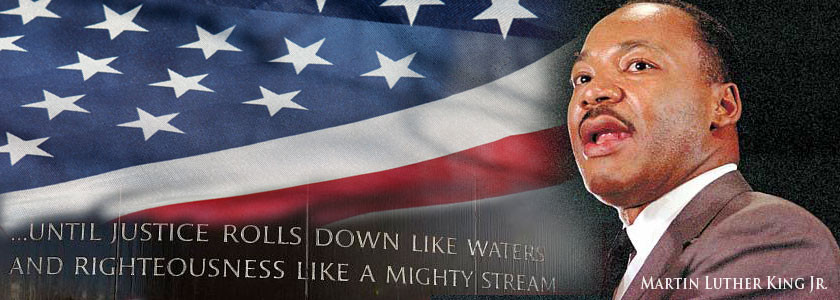Martin Luther King
Image

Martin Luther King, Jr. (January 15th, 1929-April 4th, 1968)
Martin Luther King was an American clergyman and winner of the Nobel Peace Prize. He is one of the leading figures in the civil rights movement and he has had a defining influence on the recent history of the USA.
- Born on 15th January 1929 in Atlanta, Georgia (US).
- Originally named Michael, he was later renamed Martin, like his father, a Baptist minister.
- His mother, Alberta Williams King, was a schoolteacher.
- Entered Morehouse College in 1944 and became friends with his teacher, Benjamin Mays. Together with his father's influence, it was partly his respect for Mays which led him to the Church. He was ordained in his last semester.
- Graduated from Morehouse in 1948 and undertook postgraduate study first at Crozer Theological Seminary in Pennsylvania and then, in 1951, at Boston University's School of Theology. There he completed his dissertation which and won his doctorate in 1955.
- In Boston he met his wife Coretta Scott, who he married in 1953.
- In 1954, he became pastor of Dexter Avenue Baptist Church in Montgomery, Alabama, where Rosa Parks was famously arrested for refusing to give up her seat to a white man on a bus.
National awareness
- After Parks' arrest, King came to national prominence in the US. He was a leading figure in organising the boycott by African Americans of buses in Montgomery.
- "It was thrust upon him in many respects," says John A. Kirk, Chair of History at the University of Arkansas. "In 1955-56 he came to prominence. He didn't seek out leadership. They needed a leader...King was a neutral choice. He was young and new to town and wasn't a threat."
- Tutelage from Bayard Rustin, a prominent civil rights campaigner, helped King to commit to a principle of non-violent action heavily influenced by Mahatma Gandhi's success in opposing the British in India.
- In 1957, King established the Southern Christian Leadership Conference (SCLC) with fellow activists C.K. Steele, Fred Shuttleworth and T.J. Jemison.
- As SCLC president, King was given the task of coordinating civil rights activity across the region. However, he was not immediately successful.
- “People were wondering if he was qualified to be the national leader in the late 1950s," says Professor Kirk. "There was disillusionment with King to turn his words into a tangible programme."
Birmingham campaign
- That changed in 1963.
- “King reasserted his pre-eminence within the African American freedom struggle through his leadership of the Birmingham campaign,” says Clayborne Carson, Professor of History at Stanford University and Director of the Martin Luther King Jr. Research and Education Institute.
- "The Birmingham demonstrations were the most massive civil rights protests that had yet occurred.”
- In Birmingham, Alabama, desegregation was being violently resisted by the white population. The city was dubbed ‘Bombingham’, due to the frequency of attacks on black homes and activists.
- Imprisoned and held in solitary confinement after defying an injunction against the protests, Martin Luther King wrote his ‘Letter from Birmingham Jail’. In response to criticism from local white clergymen, he set out his reasons for action in Birmingham and elsewhere.
- “For years now,” he wrote, “I have heard the word ‘Wait!’ This ‘Wait’ has almost always meant ‘Never’.”
- After his release, in May, the Children’s Crusade was launched. Thousands of school children and students staged marches in Birmingham. Television images of police using batons, dogs and high-pressure fire hoses against the young protesters sparked global outrage and won public support for King’s cause.
'I have a dream'
- Success in Birmingham provided further impetus to the movement. This culminated in the massive March on Washington for Jobs and Freedom on 28th August 1963. More than 200,000 people were in attendance at the Lincoln Memorial when King delivered his famous ‘I have a dream’ speech, predicting a day when the promise of freedom and equality for all would become a reality in America.
- However, less than a month after King delivered his speech a blast killed four young girls in a Birmingham church. There was much work to be done if his dream was to be realised.
- In 1964, King was awarded the Nobel Peace Prize. That same year, a significant step forward was made with the passage of the Civil Rights Act. The Voting Rights Act followed in 1965, removing many of the barriers which had ensured African Americans could be disenfranchised in some states.
Move to Chicago
- He turned his attention to the poor in the north. He moved with his family to an apartment in Chicago’s black ghetto in 1966. Segregation was an economic reality and the Chicago Campaign sought to combat this. However, King found that tactics which had worked in the South were less effective in the North.
- There was also growing support from within the movement for more militant methods of opposition. King found his message of non-violent action increasingly marginalised and his popularity waning.
- His opposition to America’s involvement in the Vietnam War further inhibited his influence on national policy.
Death
- The Poor People’s Campaign was established in December 1967. SCLC lobbied the government to improve their efforts in combating poverty. On 3rd April 1968, he arrived in Memphis, Tennessee to prepare for a march in support of striking sanitation workers.
- The following day, he was shot dead on his hotel balcony. The President, Lyndon B. Johnson, called for a national day of mourning.
- At his funeral, King's old friend Benjamin Mays delivered the eulogy: "Martin Luther King Jr. believed in a united America. He believed that the walls of separation brought on by legal and de facto segregation, and discrimination based on race and colour, could be eradicated. As he said in his Washington Monument address: ‘I have a dream’.”
